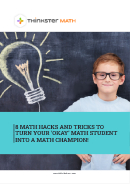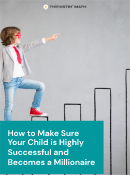How can we use the concept:
We can use circle graphs to analyze data. Circle graphs can use fractions, percentages, or actual values of the given data.
Practice and master statistics and data concepts with our helpful walkthroughs and downloadable practice worksheets from our team of elite math educators.

By Dana Valdez
Learn about circle graphs and how to use them to solve problems. Find the definition, example problems, and practice problems at Thinkster Math.
Why is this concept useful?
Where does this concept fit into the curriculum?
How can we use the concept:
We can use circle graphs to analyze data. Circle graphs can use fractions, percentages, or actual values of the given data.
1. The circle graph shows the percent of each type of flower a nursery sells. What percent of flowers are not biennials?

Answer:
To solve, find the sum of the percent of flowers that are not biennials.
52% + 20% = 72%
72% of the flowers are not biennials.
2. An ice cream store recorded its weekly sales for the different flavors of ice cream it sells using a circle graph. What percentage of sales is chocolate chip?

Answer: The sum of all percents in a pie chart is 100%. Find the sum of the given percentages and subtract it from 100% to find the percentage of chocolate chip.
10% + 23% + 12% + 8% + 19% = 72%
100% - 72% = 28%
28% of sales is chocolate chip.
3. The circle graph shows the results of a survey of 96 students who were asked what their favorite hobby was. How many students chose stamp collecting?

Answer:
The circle graph shows a fraction of the total number of students surveyed. To solve, find ⅜ of 96.
⅜ x 96 = 36
36 students chose stamp collecting as their favorite hobby.
4. To celebrate his son’s birthday, Mr. Smith ordered 100 balloons to decorate the party hall. The circle graph represents each color balloon as a fraction of the total balloons.
Part A: What is the fraction of orange balloons?
Part B: How many orange balloons were there?

Answer:
For Part A, the sum of the fractions is 1. Find the sum of the given fractions, and subtract it from 1.
1 -
For Part B, find
10 balloons are orange.
Take advantage of our free downloadable resources and study materials for at-home learning.

One thing we teach our students at Thinkster is that there are multiple ways to solve a math problem. This helps our students learn to think flexibly and non-linearly.
Get PDF
As a parent, you hope your child is extremely successful and likely become the next Gates, Zuckerberg, or Meg Whitman. To set your child on the right path, there are many skills and traits that you can start building and nurturing now. Doing so plants the seeds for future success.
Get PDF1. The circle graph shows the amount of time (in hours) Richard spent on a project each day during the week. On which day did Richard spend the most time on the project?

2. The circle graph shows the percent of sales for a company that was generated by each type of advertising that they used. What percent of sales was generated by online advertising?

3. The circle graph shows the results of a survey of 96 students who were asked what their favorite hobby was. How many less students chose reading books than photography as their favorite hobby?

4. The circle graph shows the amount of different juices used (in milliliters) to make 1 liter of fruit punch. How many milliliters of apple and grape juice was used in 3 liters of the fruit punch?

Parents like you are always looking for tips, suggestions, and activities to help their child become the best they can be! Learn more from our expert educators by visiting our blog.
Explore BlogWith personalized attention from elite math tutors, help your child gain confidence in their math skills.
Enroll for Guaranteed ResultsDoes your child struggle with math homework or understanding tricky math concepts? Do they do okay in math, but express excitement to learn new material or advanced math?
A Thinkster Math tutor provides one-to-one support to help elementary, middle school, and high school students build confidence and master math subjects like K-8 math, pre-algebra, algebra, geometry, calculus, and more.
Our expert math tutors customize math lessons to your child’s unique needs, making learning math fun and effective. We help students improve grades, develop strong critical thinking skills through solving word problems, excel in standardized tests, and develop strong problem-solving skills.
Our expert math tutors are ready to help make your child a champion and develop strong math mastery! Sign up for our 7-day free trial and get the best math tutor for your child today!
Start 7-Day Free Trial